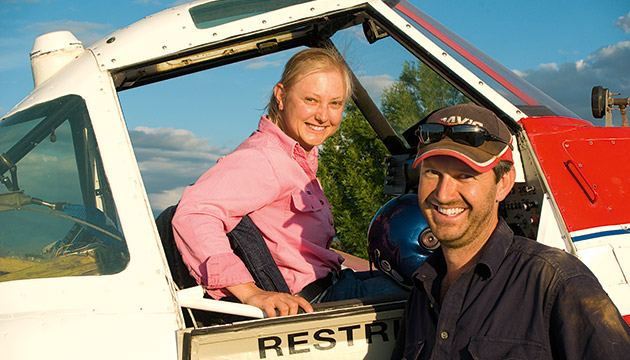Persistence and a farming background have paid off for agricultural pilot Georgia Maxwell.
Story By Kathy Mexted
Working days are “low ponytail days” for Georgia Maxwell, who ties her blonde hair at the nape of her neck to fit under her deep-blue flight helmet. Although a couple of women have entered the industry in recent years, for most of her 10-year career Georgia has been the only female fixed-wing pilot actively involved in aerial agriculture in Australia.
“I grew up on a cotton farm at Wee Waa, NSW, and just behind our place was an aerial agricultural business,” she says.
“I was always intrigued by the aeroplanes and the work they did. When it came time for university, I chose a three-year aviation degree at Newcastle. My mother was delighted because she thought she’d enjoy flying first class if I scored an airline job.”
Around the same time she started the course, Georgia’s father bumped into one of her old school friends, Lee Maxwell, who was farming cotton nearby. “Dad invited Lee to my 18th birthday party and we’ve been together ever since,” Georgia says. During a mid-year break from uni, Georgia visited Pay’s Air Services, an aerial operations company in Moree where pilot Paul Knight took her up in an Air Tractor. “There was no doubt after that about what I wanted to do,” Georgia says. She wanted to come home, be with Lee and be an ag pilot. “Don’t ask which she loves more,” husband Lee whispers.
In 2001, when she finished uni, Georgia began a career with Pay’s, working two seasons as a marker (putting out lights to guide spraying planes at night), a mixer (mixing chemicals for spraying) and a ferry pilot. “It was the beginning of the drought and work was scarce, but a farming background and uni degree have come in handy,” the 32 year old says. “I manage the company’s website and assist with regulatory compliance issues.”
These days she works as a spray-and-spreading pilot. With the industry now booming and farmers scrambling to sow and spray crops, Georgia has gained as much flying experience in the past two years as she had in the previous eight. She began work at Pay’s with about 200 flying hours and now has 3500.
“Starting out is very stressful, not only because you’re flying so close to the ground – about three feet [91 centimetres] above the top of the crop – but you’re following the sat-nav to stay on-line, coordinating with other pilots who can be working in the same paddock at the same time, liaising with staff and the clients,” Georgia says. “There’s a lot going on when you begin, but once you settle in it becomes second nature and you begin to enjoy it.”
This story excerpt is from Issue #81
Outback Magazine: Feb/Mar 2012










